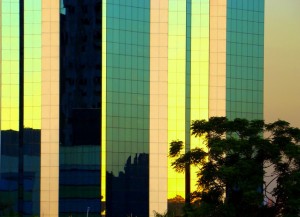Energy efficiency and glass
Float glass wasn’t mass-produced in the US until the 1800’s, and it didn’t take long for people to figure out that glass isn’t very energy-efficient. The first attempt to make insulated window glass was patented in 1865! The first insulated windows used a double-pane arrangement with an air-gap sealed by thin rope and tar. The approach is still used today, but the materials have changed a lot!
Energy efficiency drives glass improvements
As a building material, glass is very attractive, but ordinary glass doesn’t lend itself to energy efficiency. Because energy is at a premium, energy losses just aren’t acceptable today, so the quest for energy efficiency tends to drive glass technologies.
Following the attempt to create insulated glass in the mid-1800s, there were no major improvements in glass fabrication or glass technology for about 100 years. The earliest glass coatings were developed in the 1960’s. They didn’t gain a whole lot of traction, but glass manufacturers began to develop low-emissivity glass and coatings in the mid-1970s as a reaction to the energy crisis at that time. Initially, much of the glass research and development was being carried out in Europe, but by the late 1970s, more glass research and development was being conducted in the United States.
In addition to research on coatings, new techniques were being developed for applying coatings to glass. By the mid-1980s, the glass industry had settled on the use of silver in creating reflective (low-e) glass. A process known as “sputtering” was used to apply the coatings to the glass surface.
By 1990, about 20% of residential window glass was classified as low-e, even though the primary driver of the technology – the energy crisis of the 1970s – had long since passed. Low-e glass offered the primary benefit of energy efficiency, but the premium glass was developing a following because it made new homes more comfortable.
The key to energy efficiency and glass is to reduce the amount of UV light that successfully penetrates the glass. By reducing UV (and infrared) light penetration, you can control the build-up of heat in a confined space without completely sacrificing transmissible light. Glassprimer™ glass paint is designed to create a permanent bond with all kinds of glass, so no matter what kind of glass you use, Glassprimer™ glass paint can help improve the energy efficiency of glass.
If you’d like more information about working with Glassprimer™ glass paint, please check out the rest of our site. If you’d like to purchase Glassprimer™ glass paint, please visit our online store .
Photo Credit: Eduardo Hanazaki, via FreeImages.com

